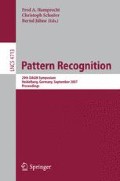Abstract
Autonomous collision avoidance in vehicles requires an accurate separation of obstacles from the background, particularly near the focus of expansion. In this paper, we present a technique for fast segmentation of stationary obstacles from video recorded by a single camera that is installed in a moving vehicle. The input image is divided into three motion segments consisting of the ground plane, the background, and the obstacle. This constrained scenario allows for good initial estimates of the motion models, which are iteratively refined during segmentation. The horizon is known due to the camera setup. The remaining binary partitioning problem is solved by a graph cut on the motion-compensated difference images.
Obstacle segmentation in realistic scenes with a monocular camera setup has not been feasible up to now. Our experimental evaluation shows that the proposed approach leads to fast and accurate obstacle segmentation and distance estimation without prior knowledge about the size, shape or base point of obstacles.
Access this chapter
Tax calculation will be finalised at checkout
Purchases are for personal use only
Preview
Unable to display preview. Download preview PDF.
References
Birchfield, S., Tomasi, C.: Multiway cut for stereo and motion with slanted surfaces. In: International Conference on Computer Vision, pp. 489–495 (1999)
Boykov, Y., Jolly, M.P.: Interactive graph cuts for optimal boundary & region segmentation of objects in n-d images. In: International Conference on Computer Vision, vol. 1, pp. 105–112 (2001)
Boykov, Y., Kolmogorov, V.: An experimental comparison of min-cut/max-flow algorithms for energy minimization in vision. In: Energy Minimization Methods in Computer Vision and Pattern Recognition, pp. 359–374 (2001)
Boykov, Y., Veksler, O., Zabih, R.: Fast approximate energy minimization via graph cuts. IEEE Transactions on Pattern Analysis and Machine Intelligence 23(11), 1222–1239 (2001)
Criminisi, A., Cross, G., Blake, A., Kolmogorov, V.: Bilayer segmentation of live video. In: IEEE Computer Society Conference on Computer Vision and Pattern Recognition, Washington, DC, USA, pp. 53–60. IEEE Computer Society Press, Los Alamitos (2006)
Greig, D., Porteous, B., Seheult, A.: Exact maximum a posteriori estimation for binary images. Royal Journal on Statistical Society 51(2), 271–279 (1989)
Hager, G., Belhumeur, P.: Efficient region tracking with parametric models of geometry and illumination. IEEE Transactions on Pattern Analysis and Machine Intelligence , 1025–1039 (1998)
Ke, Q., Kanade, T.: Transforming camera geometry to a virtual downward-looking camera: Robust ego-motion estimation and ground-layer detection. In: IEEE Computer Society Conference on Computer Vision and Pattern Recognition, pp. 390–397. IEEE Computer Society Press, Los Alamitos (2003)
Kolmogorov, V., Criminisi, A., Blake, A., Cross, G., Rother, C.: Bi-layer segmentation of binocular stereo video. In: IEEE Computer Society Conference on Computer Vision and Pattern Recognition, pp. 407–417. IEEE Computer Society Press, Los Alamitos (2005)
Longuet-Higgins, H., Prazdny, K.: The interpretation of a moving retinal image. Proceedings of the Royal Society of London, Biological Sciences, Series B, vol. 208, pp. 385–397 (1980)
Lucas, B.D., Kanade, T.: An iterative image registration technique with an application to stereo vision. In: Proceedings of the 7th International Joint Conference on Artificial Intelligence, Vancouver, pp. 674–679 (1981)
Schoenemann, T., Cremers, D.: Near real-time motion segmentation using graph cuts. In: Franke, K., Müller, K.-R., Nickolay, B., Schäfer, R. (eds.) Pattern Recognition. LNCS, vol. 4174, pp. 455–464. Springer, Heidelberg (2006)
Sun, J., Zhang, W., Tang, X., Shum, H.-Y.: Background cut. In: Leonardis, A., Bischof, H., Pinz, A. (eds.) ECCV 2006. LNCS, vol. 3952, pp. 628–641. Springer, Heidelberg (2006)
Wedel, A., Franke, U., Klappstein, J., Brox, T., Cremers, D.: Realtime depth estimation and obstacle detection from monocular video. In: Franke, K., Müller, K.-R., Nickolay, B., Schäfer, R. (eds.) Pattern Recognition. LNCS, vol. 4174, pp. 475–484. Springer, Heidelberg (2006)
Author information
Authors and Affiliations
Editor information
Rights and permissions
Copyright information
© 2007 Springer-Verlag Berlin Heidelberg
About this paper
Cite this paper
Wedel, A., Schoenemann, T., Brox, T., Cremers, D. (2007). WarpCut – Fast Obstacle Segmentation in Monocular Video. In: Hamprecht, F.A., Schnörr, C., Jähne, B. (eds) Pattern Recognition. DAGM 2007. Lecture Notes in Computer Science, vol 4713. Springer, Berlin, Heidelberg. https://doi.org/10.1007/978-3-540-74936-3_27
Download citation
DOI: https://doi.org/10.1007/978-3-540-74936-3_27
Publisher Name: Springer, Berlin, Heidelberg
Print ISBN: 978-3-540-74933-2
Online ISBN: 978-3-540-74936-3
eBook Packages: Computer ScienceComputer Science (R0)

